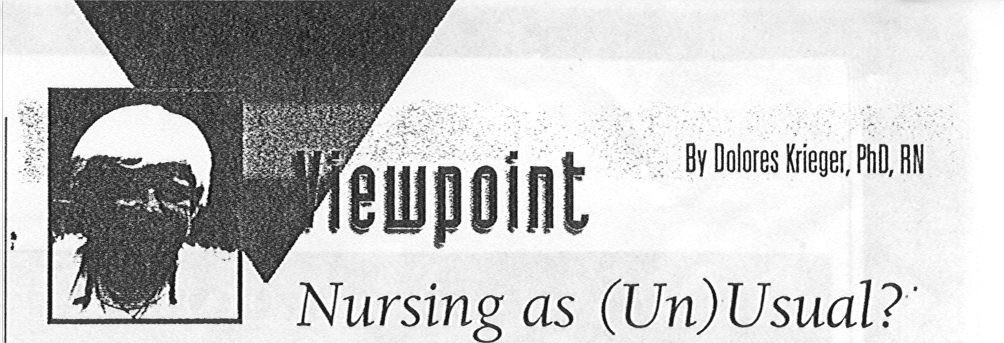

It's not news to most of us that the horizons of health care have been steadily expanding for the past 35 years. Since the early 1970s, professional nurses have made up the largest segment of audiences at workshops and conferences on alternative healing methods. During the 1980s and 1990s, holistic modalities firmly captured the public's attention. In states that foster independent nurse practice acts, nurses have increasingly turned away from workplaces that don't support creative nursing and have set up independent practices. These environments become peer forums to address longstanding problems of nursing care.
In 1972, therapeutic touch (TT) was the first holistic modality to be intrinsic to a fully accredited university curriculum. It arose out of professional nursing’s search for a modern definition of health care. And, as its popularity has grown, it has been the target of strongly reactionary forces whose viewpoints are embedded in materialistic and reductionist philosophies.
In contrast, professional nurses deal with people, and with supporting them in their self-healing-the true basis of all valid healing. It's time for nurses to take inventory of the aspirations that brought them to this profession, and to objectively scrutinize various healing modes to assess how they fit into their practice. Such self-examination can become a source of power for the individual nurse, as well as for the profession.
Therapeutic touch made worldwide headlines last year. After hearing her
parents decry nontraditional healing methods, a nine-year-old child told them that she'd thought of a way to test therapeutic touch. Driven by their resentment of TT's success, the parents-the stepfather a statistician, the mother a former nurse-worked up a methodology for their child's idea. They also engaged the services of a physician who was equally resentful of TT’s history of clinical successes (which had held up under the scrutiny of several hospital research boards in the U.S. and Canada).
The resulting article was presented, with the physician's help, to the editor of The Journal of the American Medical Association (JAMA), who published it ("A Close Look at Therapeutic Touch," April 1, 1998). As the New York Times Magazine subsequently reported (..Hippocratic Wars," June 28, 1998), JAMA’s editor then set up a worldwide media campaign to promote his publication of the study. According to the Times, his primary motive was to bolster JAMA's sales.
Fortunately, a group of professional nurses who practice therapeutic touch under the sponsorship of Nurse Healers Professional Associates, Inc., had in place a process for self-examining TT’s teaching, research, and clinical practices. In facing up to JAMA's attack, these
nurses were able to positively meet the frankly hostile, lockstep reactions of the media. Where an unbiased forum was permitted, TT’s advocates were able to demonstrate that:
Professional nurses who are considering alternative methods for their
armamentarium of nursing therapies should press for unbiased examination of any new modality. Nurses have always been known for their compassion-but we've also been characterized as passive. Isn't it time for us to become more forward-thinking-and more daring?
_______________________________________________________________________
Dolores Krieger, one of the founders of therapeutic touch and a professor emerita of nursing science at New York University, lives in Columbia Falls, MT.
The opinions expressed in this column are not necessarily those of the American Nurses Association or Lippincott Williams & Wilkins.
AJN April 1999 Vol.99,No.4